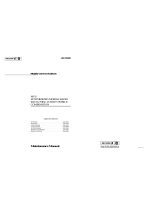DESCRIPTION
ERICSSON GE
synthesized
ORION
800 MHz
mobile
radio combinations are completely solid-state, utilizing micro-
computer technology and integrated circuits to provide high-
quality, high-reliability radios. Standard combinations may be
equipped with:
• Microcomputer Controlled Frequency Synthesizer
• Up to 192 Conventional Channels
• Up to 800 MHz EDACS Systems/Groups
• 0.00015% Frequency Stability
• Other Structured Options
The basic radio consists of three printed wiring boards
mounted in a cast aluminum frame. The three boards are:
1. The System Control Logic/IF Board,
2. The Frequency Synthesizer/Receiver/ Exciter Board
3. The Power Amplifier Board.
The radio is of double-layer construction with minimal tun-
ing adjustments.
The Control Logic/IF Board located on the top of the radio,
while the Power Amplifier and the Synthesizer/Receiver/Ex-
citer Boards are located on the bottom.
SYNTHESIZER/INTERCONNECT
The synthesizer consists of a microcomputer,
E
lectrically
E
rasable
R
ead
O
nly
M
emory (
EEPROM
), a frequency syn-
thesizer IC, transmit and receive
V
oltage
C
ontrolled
O
scilla-
tor’s (
VCO
) and associated circuitry. The frequency
synthesizer under control of the microcomputer generates all
transmit and receive
R
adio
F
requencies (
RF
).
The EEPROM stores binary data for all radio frequencies,
Channel Guard tones/digital codes and the timing function of
the
C
arrier
C
ontrol
T
imer (
CCT
). The microcomputer ac-
cesses the EEPROM and provides the correct WALSH bits to
the Channel Guard circuitry to generate the correct Channel
Guard tone or digital code on a per-channel basis.
PROGRAMMING
The EEPROM allows the radio to be programmed or repro-
grammed as needed to adapt to changing system requirements.
Radio Frequencies, Channel Guard tone and digital codes and
the CCT function can be reprogrammed.
The EEPROM can be reprogrammed through the radio rear
connector using a personal computer and personal computer
programmer software. This programmer allows all information
to be entered from the personal computer screen.
Programming instructions are provided in the respective
Programmer Maintenance Manuals.
TRANSMITTER
The transmitter consists of the exciter, frequency synthe-
sizer, transmitter VCO and a Power Amplifier (PA) assembly.
The PA assembly consists of a PA board mounted on a heat
sink assembly. The PA board also contains antenna switching
diodes and a low-pass filter.
Audio and Channel Guard circuitry for the transmitter is lo-
cated on the System Control Logic/IF Board.
RECEIVER
The receiver consists of the frequency synthesizer, RX
VCO, injection amplifiers, front end, IF and limiter detector.
Audio, squelch and Channel Guard circuitry for the receiver is
located on the System Control Logic/IF Board.
SYSTEM CONTROL LOGIC FUNCTION
A microprocessor on the System Control Logic/IF Board
controls the frequency synthesizer, the TX ON/OFF, the decod-
ing of CTCSS tones, the generation of CTCSS tones,... etc.
The audio processor circuitry of the transmitter and the re-
ceiver are located on the Control Logic/IF Board. Squelch cir-
cuitry and a connection to the digital
AEGIS
circuit is also
located on the System Control Logic/IF Board.
Continued
SPECIFICATIONS*
Maximum Frequency Separation:
857-870 MHz .... 19 MHz
Frequency Response:
Within +2, -8 dB of 6 dB/octave de-emphasis from 300 to
3000 MHz (1000 Hz reference)
RF Input Impedance:
50 Ohms
Hum/Noise ratio:
Unsquelched
Squelched
-45 dB
-70 dB
Receiver Recovery Time:
200 milliseconds
Receiver Attack Time: 150 milliseconds
Channel Spacing:
25 kHz
* These are typical specifications intended primarily for use of the service technician. Refer to the appropriate Specifications
Sheet for the guaranteed specifications.
LBI-38902
2









